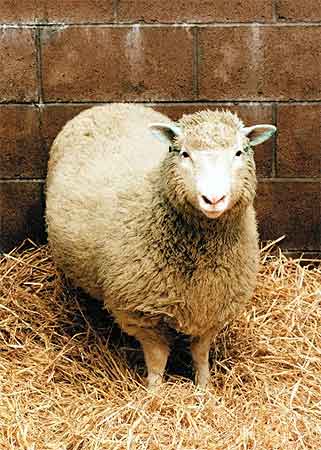When Dolly the sheep fell ill with old age at only 5 years old, it was feared that the reason was the cloning procedure itself. Now it appears that fame has cost her health - literally

20 years ago a historic event took place: Dolly the sheep was the first mammal born from a clone of an adult creature. Since then, the technology has continued to develop and mature, and Dolly itself has also undergone additional replications. A new study conducted on 13 cloned sheep between the ages of seven and nine - four of which are clones identical to Dolly herself - revealed that they are all healthy and show no signs of premature aging, contrary to the concerns that arose following the life circumstances of the first clone.
The ability to make exact genetic copies of animals may have many uses, but it is not without problems. One of the concerns was that the clones would "be born old". That is, since the cloned creature was created from an older animal (Dolly's mother was six years old when the cell used for cloning was taken from her), would he biologically be older than his chronological age? When Dolly needed treatment for osteoarthritis at the age of five, they thought that these concerns were compatible, since this is a disease that is typical of old sheep. Now it appears that this was a one-time incident.
Cloning from an adult cell
Dolly was created using a cloning method known as somatic nuclear transfer. The researchers removed the nucleus - which contains the genetic material - from the egg of one sheep and replaced it with the nucleus of a cell taken from the uterus of another sheep that was six years old at the time. The egg developed into an embryo like a normal fertilized egg, and Dolly was born as a "genetic twin" of the sheep from which the nucleus was taken.
The theory of cloning is quite simple, but the implementation is complicated. In the process of creating the egg, the chromosomes - the molecules of the genetic material - undergo changes that prepare them for their role in the cell from which the embryo is formed. In contrast, chromosomes in body cells undergo their own changes, designed to allow them to fulfill their functions, and during life they accumulate additional changes.
Not all of these differences between body cells and egg cells are known and fully understood by us, and it is difficult to reproduce them in the cloning process. This is one of the reasons why clones don't always work: Dolly herself was the only survivor of 277 eggs into which they transferred foreign nuclei, and even today the success rates of mammalian clones are quite low.
When Dolly fell ill with the disease characteristic of old sheep, some believed that it was a result of the cloning. It was hypothesized that the chromosomes taken from the udder cell arrived in the egg bearing signs of their advanced age, and bequeathed them to all the cells of the developing embryo. Dolly was born with genetic material that resembled that of a six-year-old sheep - she was born old, and at the age of five she was already really old. A year later she died, at a young age (the average lifespan of sheep of her breed is 12-11 years), but her death was caused by a virus common in sheep and was probably not related to her being cloned.
Premature aging?
In the current study, Kevin Sinclair (Sinclair) and other researchers from the University of Nottingham in the UK tested 13 cloned sheep, male and female, and were at the time 9-7 years old. Four of them were created from the same cells as those that created Dolly, and were therefore genetically identical to her.
In an article in the journal Nature Communications, the researchers detailed a long series of tests the sheep underwent, starting with a blood pressure test and ending with an MRI. A few of them had mild arthritis, and one had a slightly more severe inflammation, but these are not unusual findings in sheep of their age. None of the sheep or rams were found to have high blood pressure, diabetes or any other disease related to old age. The researchers concluded that cloning does not cause premature aging or any long-term damage, as far as can be deduced from the small sample.
So why did Dolly get old sheep disease and die young? It is possible that the reason lay in her living conditions, and not in the clone itself. As the first cloned mammal, her lifestyle was very different from that of normal sheep. Instead of grazing in the field, she spent most of her time in closed rooms, where her owners could keep an eye on her and introduce her to researchers and journalists. Unlike other sheep, she did not have many opportunities to run and stretch her legs, which may have led to the arthritis she suffered from. The virus that eventually killed her also mainly infects sheep that are in closed spaces.
The findings of the new study do not guarantee that cloning technology is completely safe or effective. The success rate of such clones is still low, and many embryos do not survive the pregnancy, or die from genetic diseases in infancy. However, it appears that those who survive the first months grow up to be healthy creatures no less than any other animal of their kind, and do not show any signs of premature aging - as long as they enjoy adequate living conditions.

One response
Cloning stops the evolutionary process. There are reptiles in which cloning is common (for example, a female Komodo dragon - which laid eggs without fertilization, and healthy offspring hatched).